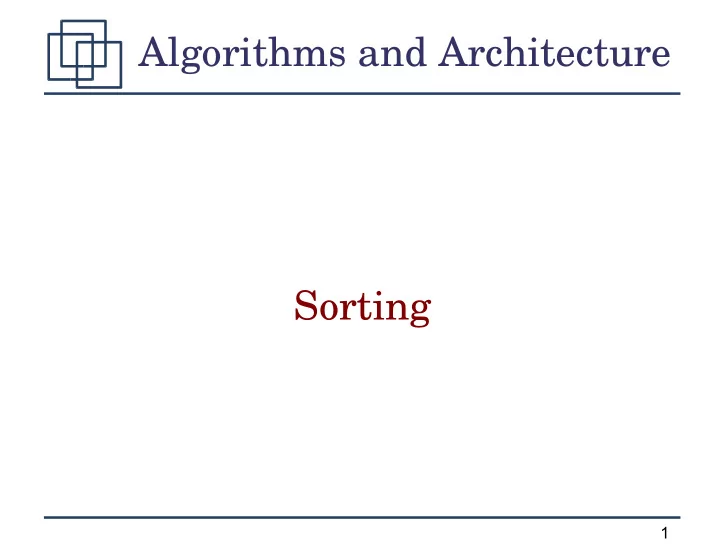

Algorithms and Architecture Sorting 1
The Problem ➢ Input : a sequence of n numbers <a 1 ,a 2 ..a n > ➢ Output : a permutation (reordering) <a 1 ',a 2 '..a n '> of the input sequence such that a 1 ' ≤ a 2 ' ≤ .. ≤ a n ' ➢ Numbers to sort are also known as the keys 2
Sorting Algorithms ➢ Bubble sort 2 ➢ Selection sort n ➢ Insertion sort ➢ Merge sort ➢ Quick sort nlog 2 n ➢ Heap sort – application: priority queues 3
Bubble Sort ➢ Pseudo code, array from 1 to n , pb 2-2 p38 ➢ for i:=1 to n-1 do for j:=n downto i+1 do if a[j]<a[j-1] then swap(a[j],a[j-1]) ➢ Loop invariant: sub-array a[1..i] is sorted before loop (on i) . ➢ Running time: n-1+n-2+...+1=n*(n-1)/2 Θ (n 2 ) 4
Selection Sort ➢ Exercise 2.2-2 p27 ➢ for i:=1 to n-1 do for j:=i+1 to n do if a[i]>a[j] then swap(a[i],a[j]) ➢ Loop invariant: sub-array a[1..i] is sorted before loop (on i) . ➢ Running time: n-1+n-2+...+1=n*(n-1)/2 Θ (n 2 ) 5
Insertion Sort ➢ for j:=2 to n do key:=a[j] i:=j-1 while i>0 and a[i]>key do a[i+1]:=a[i] i:=i-1 a[i+1]:=key ➢ Loop invariant: sub-array a[1..j-1] is sorted before loop (on j) . ➢ Running time: Θ (n 2 ) 6
Analysis of Insertion Sort ➢ Count executions of loops – test n times, execute n-1 times (outer loop) – test t j times, execute t j -1 times (inner loop) n c 1 c 2 n c 3 ∑ j = 2 – t j ➢ Analysis – best case: t j =1, T(n)= Ω (n) – worst case: t j =j, T(n)=O(n 2 ) – average case: t j =j/2, E[T(n)]=O(n 2 ) 7
Merge Sort ➢ Divide-and-conquer approach – apply to algorithm that are recursive – divide main problem into sub-problems – conquer the sub-problems (solve recursively) – combine the solutions of the sub-problems ➢ Merge sort: – divide array n into 2 arrays of size n/2 – sort 2 smaller arrays with merge sort – combine smaller arrays 8
Merge Sort ➢ Key: merge sorted sub-arrays A[p..q] and A[q+1..r] . For n elements merged T(n)= Θ (n). ➢ Merge-sort( a,p,r ) : if p<r then q:=(p+r)/2 Merge-sort(a,p,q) Merge-sort(a,q+1,r) Merge(a,p,q,r) ➢ Merge described using copies and sentinel values 9
Analysis of Merge Sort ➢ Running time T(n) given as a recurrence. In general for divide-and-conquer algorithms: T(n)= Θ(1) if n ≤ c ( c : small enough) otherwise T(n)=aT(n/b)+D(n)+C(n) . ➢ You are masters in recurrences, easy! ➢ Merge-sort: c=1, D(n)=1, C(n)= Θ (n) (combine), divide: a=2 and b=2. T(n)= Θ (n lg n) 10
Quick Sort ➢ Divide-and-conquer algorithm. Worst case Θ (n 2 ) but average case Θ (n lg n) and in practice VERY efficient. ➢ In place algorithm with small constants for the complexity. Fastest sort in practice except for “almost-sorted” inputs. ➢ We will check it in the exercises. 11
Quick Sort ➢ Divide: partition A[p..r] into A'[p..q-1] and A'[q+1..r] s.t. a' p..q-1 ≤ a' q ≤ a' q+1..r . Compute q. ➢ Conquer: sort A'[p..q-1] and A'[q+1..r] by recursive calls to quicksort. ➢ Combine: A[p..r] is sorted, nothing to do! ➢ Key: partitioning. We can choose a' q arbitrarily. 12
Quick Sort Partitioning ➢ Partition( A,p,r ) x:=A[r] // pivot element i:=p-1 for j:=p to r-1 do if A[j] ≤ x then i:=i+1 swap (A[i],A[j]) swap (A[i+1],A[r]) return i+1 ➢ Equivalent to selection-sort for worst case. 13
Performance of Quick Sort ➢ Depends on the input (balanced array or not) and the choice of the pivot. ➢ Worst-case (sorted, reversed, or equal elements): Θ (n 2 ). ➢ Best-case (balanced): T(n) ≤ 2T(n/2)+ θ (n), i.e, T(n)=O(n lg n). ➢ Average case? – remark: case 1/10 – 9/10 is still in n lg n. – it is O(n lg n). 14
More Quick Sort ➢ Randomized quicksort – There is no worst-case input, but an unlucky run may result in T(n)=n 2 . – Choose the pivot randomly, i.e., swap a random element with A[r] . ➢ Hoare partitioning (pb 7-1) – possibly fewer swaps – common pivot:=A[(p+r)/2] 15
Heap Data Structure ➢ See it as a binary tree ➢ root = A[1] (root of the tree) ➢ parent(i) =i/2 (for a node i) ➢ left(i) =2i (left child) ➢ right(i) =2i+1 (right child) ➢ max-heap property: A[parent(i)] ≥ A[i] ➢ or min-heap property: A[parent(i)] ≤ A[i] ➢ height is Θ (lgn). 16
Heap Sort ➢ Max-heap for sorting (ascending). ➢ Basic proceedures: – max-heapify : maintains max-heap property O( lg n). – build-max-heap : computes a max-heap O(n). – heapsort : sorts an array in place O(n lg n). – others for priority queues (later). 17
Maintaining a Heap ➢ max-heapify(A,i) – assume that left(i) and right(i) are max-heaps. – A[i] may be smaller than its children. – (simplified) algorithm: child:=A[left(i)] > A[right(i)] ? left(i) : right(i) if A[i]<A[child] then swap(A[i],A[child]) max-heapify(A,child) – when the algorithm terminates, the max-heap property is restored. Clearly O( lg n). 18
Building a Heap ➢ We can use max-heapify in a bottom-up manner: build the tree incrementally. ➢ build-max-heap(A): heap_size[A]:=length(A) for i:=length[A]/2 downto 1 do max-heapify (A,i) ➢ Clearly O(n lg n). ➢ Why do we start from length[A]/2? 19
Heap Sort ➢ Build a max-heap, put the root element at the end of the heap, max-heapify with a smaller heap, repeat. ➢ heap-sort(A): build-max-heap(A) for i:=length(A) downto 2 do swap (A[1],A[i]) heap_size(A)-- max-heapify (A,1) ➢ Clearly O(n lg n) , but also Ω (n lg n) (bad). 20
Priority Queues ➢ Heaps are useful for priority queues because of the max(or min)-heap property. ➢ Operations: – insert an element – get the max (or the min) element – remove the max (or the min) element – increase key of an element ➢ Used in the STL 21
Recommend
More recommend